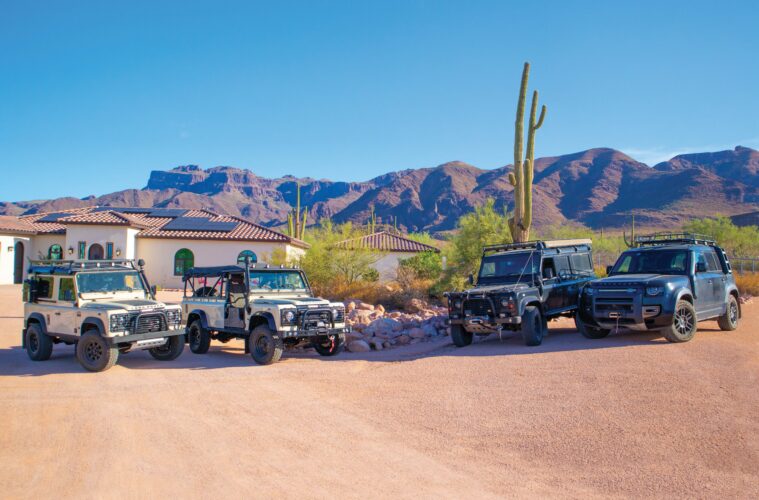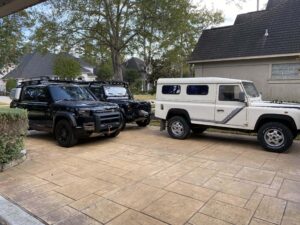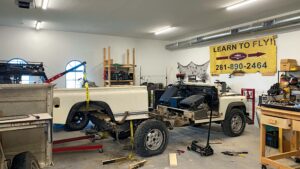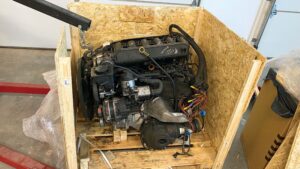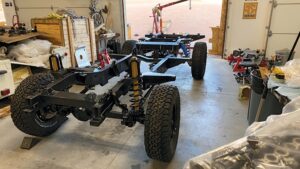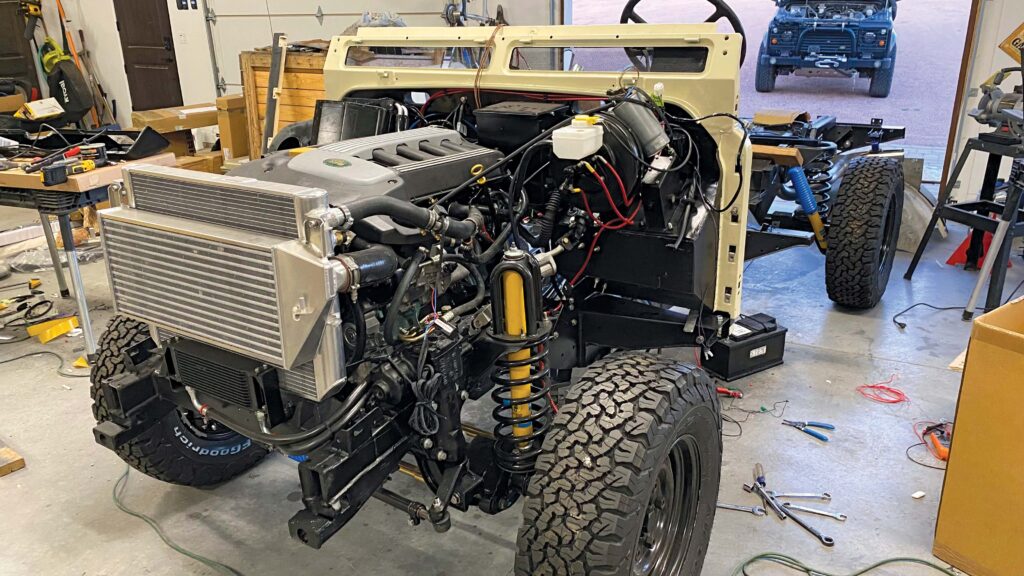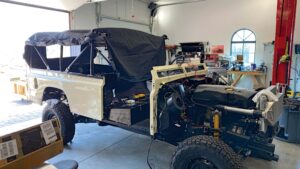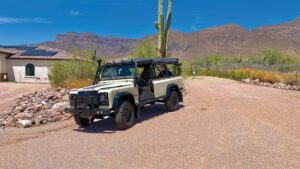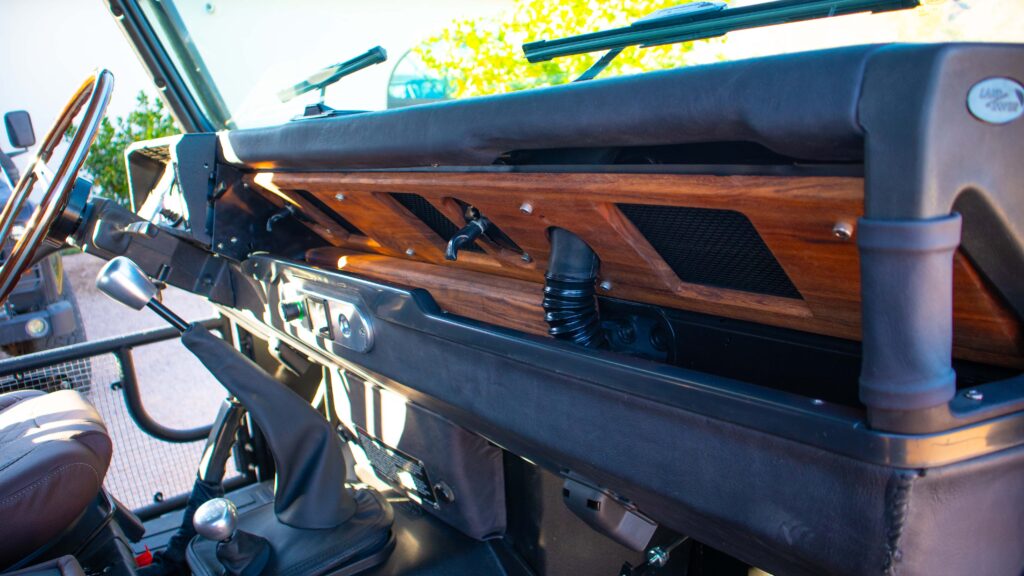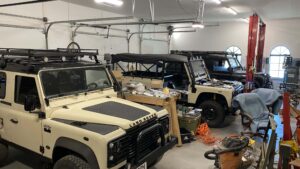In my first career on Wall Street, I created and marketed intangible items of value. Once it ended, I knew that spreadsheets and offering memoranda would no longer grant me a sense of accomplishment. I knew I wanted to create tangible, useful things; after all, you can’t “feel” a website or hold the cover jacket of an MP3. Instead, I turned to Land Rovers.
In 2015, the purchase of an ’86 Defender 110 from the UK firm, Arkonik, launched my new adventure in life. After two engines and much off-road kit, I realized doing this kind of work had become a satisfying endeavor. I could indulge in crafting custom vehicles and take pride in producing something real.
I started my first intentional rebuild project with a ‘91 Defender 90 in the confined space of my home garage in Texas; I doubt that my newfound project thrilled my neighbors, either. I demonstrated little due diligence, too, and thus learned, the hard way, of the common problems inherent in old Defenders: rusty chassis and/or bulkhead, corrosion from dissimilar metals, neglected gearboxes, etc. I was not interested in slapping on some new paint and tires just to resell a tired Defender. My goal was a complete restoration of the vehicle: every bolt removed, major parts rebuilt, and adding some modern improvements to hopefully make it better than when it rolled off the Solihull production line.
I justified many costly replacements and add-ons as a learning experience and looked to reduce expenses by doing all the work myself: engine rebuild, bodywork and paint, among other tasks. While I finished the Defender and sold it in a reasonable amount of time, my Wall Street upbringing forced the admission that my overall profit margin remained firmly in the red. “An investment in experience,” I told myself. “I’m sure I’ll make money in the future.” (In a perverse way, I did, when it came up for sale and I bought it back for less money than I sold it for!)
Then I moved to Arizona, where I purchased a dedicated, 1,800 square foot shop building. It provides ample room to scatter the 10,000 pieces of the deconstructed Defender 110 three-door that I wanted to convert to a two-door soft top. From this point, I gave in to the multitude of temptations to customize and replace just about everything. The project morphed into an endless cascade of upgrades because of my driving goal to emerge on the other side with a like-new Defender (at least in the sense of a bygone era where an automobile consists of more than just a collection of computer nodes).
This adventure started with a donor ’89 Defender 110 with a charming (but useless) 2.5L turbodiesel. The Defender had deteriorated to a point that necessitated the replacement most of its parts other than the VIN number. The desire to ferret out every last piece of rust and unrepairable damage turned the project into a no-compromise, bottom-up rebuild. I could not even retain the patina parts to honor its “heritage” without rendering the build looking incomplete. Once again, this seemed insensible financially; yet the end result would provide the comfort that no demons lurked beneath a shiny paint job.
I went through stacks of cutting discs and reciprocating blades to salvage the parts that were worthy of rehabilitation. Months of cleaning, sandblasting and coating were worth the effort to save the parts of this icon that were still functional. I could then place some massive orders at Rovers North to get what I needed to build the rolling chassis.
For the engine, I contemplated either a 300 Tdi or a Cummins R2.8 (an LS3 just seemed out of place.) A friend at Britannica Restorations in Canada suggested a BMW M57 engine. I sourced the M57 out of a ’05 Range Rover L322 from a breaker in Germany. It looked as neglected as my donor Defender, but after a full strip-down, the tolerances of the block and head were within specification. Most of the internals and ancillaries required replacement, but the Land Rover and BMW supply chains provided everything needed for the rebuild.
A 200 Tdi Marsland chassis seemed to be the best choice for the engine swap since the mounting brackets line up well for the M57. After finding a freight carrier to ship a chassis from Rovers North in Vermont to Arizona, the rolling chassis came to include an Ashcroft 4-pin front differential, heavy-duty axle shafts and CV joints, uprated brakes, a R380 gearbox with strengthened bearings and a 1.1 ratio LT230 transfer box.
The engine fitment presented an unplanned challenge; the M57 engine swaps I watched online were into RHD drive Defenders. With a LHD, the alternator on the M57 would not fit past the steering box. The best, but not least expensive solution would involve the installation of a steering box from a P38 Range Rover, as it mounts outboard of the chassis. But even with the new parts, the steering box still obstructed the alternator. My solution was to build a custom bracket and move the alternator to the other side of the engine in place of the A/C compressor. With several more custom brackets, some custom coolant hoses and a custom box to house the ECU and engine electrics, the engine fit correctly in its new home.
I sought to improve my meager woodworking skills by creating a new wood deck in the rear and a wooden dashboard. For the rear deck, I chose African Iroko for its similarity to teak in terms of weather resistance but more sustainable. The floor in the rear has caulked grooves where the boards meet to prevent water seepage. Those same reasons dictated the use of the Iroko wood for the fascia (does water ever seep into a Defender L316?). The addition of wood gives a subtle feel of comfort not possible for me with plastic.
The conversion to a soft top led me to think of opening up the rest of the Defender. I considered installing split doors but went further by building tubular half doors. The look of the original Land Rover Series grille inspired me when shaping the tubes and the stainless woven mesh. With the sides of the top rolled up while trekking down my favorite trails, the open feel the half doors provide brings me closer to the natural environment. When full doors are necessary, I’ve installed hinges that allow for an easy switch.
This build has taken about one year to date. I have a list of 50 items to sort out before the Defender is ready for prime time. The custom designs and fabrication work pushed my skills to their limits and have made this a favorite build. I’ve learned that if I can envision an exciting product, I will find a way to create and build it – despite a lack of formal training in automotive engineering. I’m unsure as to my next Land Rover build, but I’m confident it will go “above and beyond” a restoration to allow me to produce something special for myself.
